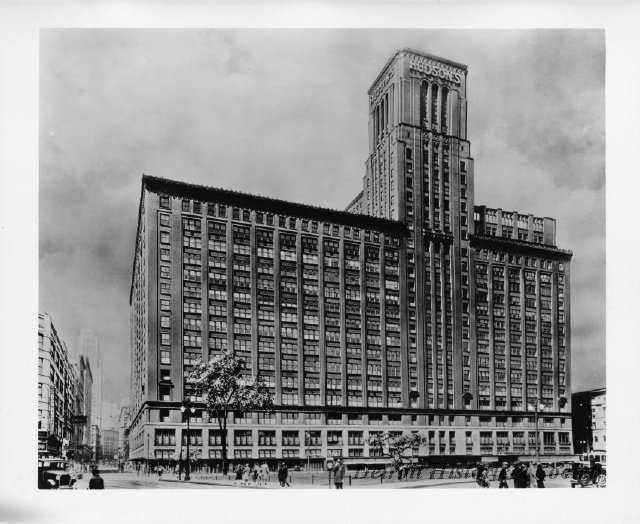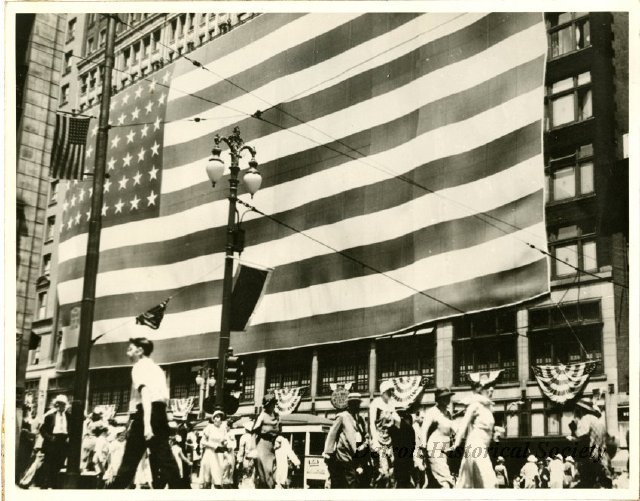The J.L. Hudson Company, generally known as Hudson’s, was a large retail department store chain that originated in Detroit. Joseph Lowthian Hudson, 35 years old at the time, founded the company in 1881. Originally a clothing store for men and boys, it was first located in the old Detroit Opera House building. The store directly competed with C.R. Mabley, where Hudson had previously worked.
In 1891, Hudson moved his store to Gratiot Avenue and Farmer Street, where the store would grow to encompass an entire block, eventually filling the space between Woodward Avenue and Farmer, Gratiot and Grand River Avenue. The store grew to a 25-story structure that was the world’s tallest department store until 1961. At one point, Hudson’s claimed it was also the second largest store in the country in terms of square feet (two million), after Macy’s Herald Square in New York City.
Hudson’s had the unique distinction of owning the world’s largest flag. At 3,700 square feet, it was first hung on Armistice Day in 1923 and later displayed at the World’s Fair in 1939. The original flag, last displayed in 1949, was replaced with a new, even larger, seven-story flag. Hung for the final time on Flag Day in 1976, the flag was donated to the Smithsonian Institution who later gave it to the American Flag Foundation in Houston.
Hudson’s was also host to Detroit’s first Thanksgiving Day Parade in 1924, comparable to the Macy’s Parade in New York City. The end of the parade brought Santa Claus, signaling the holiday season, and was one of Detroiters’ favorite traditions. The children’s toy floor was a sight to behold for young kids, decked out in holiday decorations.
The store’s famed delivery department included 300 trucks and 500 drivers. Its five restaurants served thousands of meals daily. By 1953, the store reportedly had 12,000 employees and racked up an average of 100,000 sales a day. In addition to the standard department store features, Hudson’s had a circulating library, a writing lounge, and offered dry cleaning. The business boasted more than 700 fitting rooms, 51 passenger elevators and several basements.
The store gradually expanded to the suburbs because of the metropolitan area’s three million population, and the increasing traffic and parking problems downtown. The first suburban store was at Southfield’s Northland Center, which, when it opened in March 1954, was the largest shopping center in the nation and was a subsidiary of the Hudson Corporation. By 1978 there were nine satellite Hudson’s locations in the metro area, plus several outstate. The company also operated stores in other cities and other states. In 1960 the downtown store hired its first African American bus girl, a high school student named Diana Ross who would later make musical history. In 1962, the business boasted two, one million-dollar sales days.
But as the City of Detroit began to suffer from the economic downturns of the 1970s and 1980s, so did Hudson’s. In 1969, the Dayton Co. purchased Hudson’s, becoming the Dayton-Hudson Corporation. Gradually, the comfort and free parking of suburban locations lured shoppers and the downtown Hudson’s began to slowly downsize, closing in 1983. The building was sold in December of 1989 and nearly one decade later, on October 24, 1998, the structure was imploded.
In 2000, Dayton-Hudson rebranded as the Target Corporation, taking the name of their successful chain. Remaining Hudson’s and Dayton’s stores were re-branded as Marshall Fields. They became Macy’s locations after another buyout.

